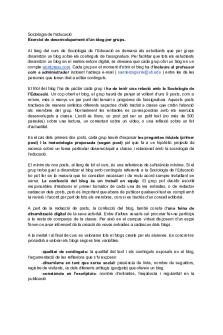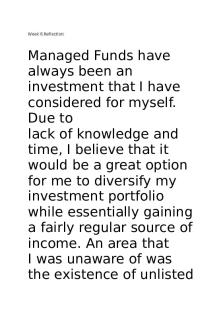Leadership Blog Reflection PDF

| Title | Leadership Blog Reflection |
|---|---|
| Course | Leadership and entrepreneurship |
| Institution | Western Sydney University |
| Pages | 6 |
| File Size | 371.3 KB |
| File Type | |
| Total Downloads | 94 |
| Total Views | 127 |
Summary
Download Leadership Blog Reflection PDF
Description
Leadership Blog Portfolio The “Image of Leadership” activity has allowed me to understand to importance of learning about leadership. When researching and reading for information about leadership, creating images that represent that about it as well as interacting with other people’s posts, I understood that leadership can be interpreted in many ways. For my individual image (see appendix 2), I created my image with my basis on the concept of unity, closeness, and participative (see appendix 1). I do value leadership in a participative way rather than an individualist way. Participative leadership is where everybody can work together with the leader when it comes to finalising the last decision (Lam et al 2015). Unity and closeness are words that I associate with the participative style since efficiently engaging with the team members can create close relationships and maybe close relationships. Then with the topic associated with week 12 of “Leadership values,” I delve that they are my core values of leadership (Carlson 2015). Then when our group shared our ideas for our group image, we had the same ideals (see appendix 3) which were drive, motivation, and rise. With our explanation, drive explores how the leader is the force that leads the teams to be successful as the leader in the front on the paper plane. The motivation is represented by blue where the leader in dark blue has given a source of motivation to the team members as they are coloured in a light shade of blue. Then rise is displayed where the paper plane is going up to the sky as everyone on it flies it upwards. In the theoretical aspect, our group was inspired by the contingency theories of leadership but specifically the contingency model and the path- goal theory (Ronald 2014). The contingency model is where leadership is delivered depending on the situation or event. The leader tends to focus on task achievement or interpersonal relationships. With our image (appendix 4), the leader and the team members are both in shades of blue with the former being a darker blue. This interprets where the leaders can bring out the potential drivers of the team by adapting to the situation and using that to go towards the goals of the leader and the team. The path goal theory is where the leader’s most practiced style as a motivation to get followers the achieve goals (Polston-Murdoch 2013). The theory ties with the image were with the same colour scheme of blue with the leader and the team member which represents how the leader shapes the paths of the members and organisation goals (Ronald 2014). Additionally, they all have the same pose so they can rise to success. This displays motivation where the blue and the pose delivers the communication and interaction so that the plane which displays success, goes up. My depiction of leadership was just mainly based on the involvement of the team members' opinions that will help and influence the direction that the leader will choose so that the group can succeed. In my revised understanding through collaborations and research, leadership has many different modes. There is the trait leadership theory where it includes the laissez-faire
leadership. It is where the leader gives out the needed material and does not include themselves with the events and courses of the activity (Ronald 2014). Then there is the leader continuum where it measures the leadership where if the behaviour is authoritarian, the less participation and freedom that the team members have in the decision making. If the behaviour is participative then team members would be more encouraged to participate when it comes to the decision making (Ronald 2014).
Through the interaction and collaboration with the other students commenting on the images, I have deeply understood that leadership can be displayed from many perspectives which revised my knowledge of leadership. In appendix 1, Danhil has commented that closeness was never been experienced when he has worked in a big team. This can display the opposite of the participative leadership style and towards the authoritarian style. The authoritarian style is where leaders are in full control power of members and make unilateral decisions without the input over the subordinates (Zhang & Xie 2017). This style can put atmosphere within the team with pressure and tension which leads the structure to produce more hostility (Ronald 2014). Danhil’s experiences can reflect on this and additionally, he commented how groups should be more open, transparent, and open with each other exploring how he wished he would have experienced those traits. Then when it comes to the group image (appendix 3), Miguel commented on the group image where he mentioned that he ignored the importance of motivation as he acknowledges the importance of it to be the driver to group success. Motivation is one of the bases of theory Y. Theory Y plus theory X are two leadership styles that contrast each other. Theory X is where workers are predestined to work that is led by external control. Theory Y acts where workers will work in a participative working environment so they can pull out full potential and creativity while working (Roland 2014). Also, motivation is a vital factor that associates with satisfaction when it comes to group ethnic under the participative leadership style. Miguel wished that he should have implemented more motivation in his leadership style since he realises that motivation can stimulate to success as a group. Throughout the collaboration, besides the theories that reflect on the experiences, leadership has been based on core values. Core values are what the individual thinks what is the most important in their livelihood (Carlson 2015). When it comes to the three words that describe the image, each student shared different words from their perspective showcasing how each person has different core values. For example, in appendix 5 where Faisal shared how she thinks that “inspire, lead change and shared vision” represent leadership. Although I still believe in the participative way of leadership, collaborating with the other students has made me further learn that leadership should be delivered where group members are satisfied with the leaders. Due to the negative experience that Danhil had when he was a team member and the uncertain past that Miguel had as a leader, leadership should take form in a much more positive light so the group can be happy and motivated to work towards group success. Additionally, Miguel’s leadership experience showcased how he could have been better with adding certain attributes such as motivation so to me, leading can progressively become better through reflection and self-awareness (George 2015) to become a better leader in future groups.
To conclude, there are many aspects that I want to strengthen when I encounter leadership roles in my future career. Firstly, I want to be a more authentic leader. Being an authentic leader involves being around people that share the same values (George 2015) and those people would be more likely to give trust to those people. I honestly want to lead a group where I can be realistic without being another persona so that I can deliver where I can just be myself. To add to that, I want to into core values add more into my future career (Carlson 2015). Some core values that I think are important, but lack right now are confidence and power. As a person who is timid and quiet, when I lead a group, I do have a hesitancy when it comes to telling people to do some small tasks and where there are situations where some team members disagree with ideas, and I am not sure how to come up with a solution. So in the future, I passionately want to build up the confidence and power to lead a team even when it comes to disputes and importantly, the direction towards success. Lastly, I would like to also adapt the transformational theory of leadership (Ronald 2014). Although I have a leadership style where I involve everybody’s ideas in the final decision making, I would like to aspire the team members with intrinsic motivation. This involves being able to create a vision where team members would like to accomplish but I, unfortunately, lack realistic outcomes as I like to think too much outside of where a goal is impossible to be accomplished. Additionally, I would like to learn how to lead into hard challenges and encourage people how to bring out their creativity,
Appendices Appendix 1
Appendix 2
Appendix 3
Appendix 4
Appendix 5
References Carlson, L 2015, ‘Leading through core values’. Leader to Leader, 2015: 61-66. https://doiorg.ezproxy.uws.edu.au/10.1002/ltl.20193 George, B 2016, ‘Rise of true north leaders’, Leader to Leader, 2016: 30-35. https://doiorg.ezproxy.uws.edu.au/10.1002/ltl.20215 Lam, CK., Huang, X. & Chan, SC 2015. ‘The threshold effect of participative leadership and the role of leader information sharing’. Academy of Management Journal, 58(3), pp.836-855. Polston-Murdoch, L 2013. ‘An Investigation of path-goal theory, relationship of leadership style, supervisor-related commitment, and gender’. Emerging Leadership Journeys, 6(1), pp.13-44. Ronald, B 2014, "Comprehensive Leadership Review - Literature, Theories and Research", Advances in Management, vol. 7, no. 5, pp. 52-66.
Zhang, Y. & Xie, YH 2017. Authoritarian leadership and extra-role behaviors: a roleperception perspective. Management and Organization Review, 13(1), pp.147-166....
Similar Free PDFs

Leadership Blog Reflection
- 6 Pages

Unit 6 bonus reflection blog
- 2 Pages

BLOG 1 - BLOG
- 3 Pages

Evidence Blog Pet peeves blog
- 1 Pages

12min Blog
- 4 Pages

Exercici blog
- 2 Pages

Week5 - blog
- 6 Pages

Discussion Blog
- 1 Pages

Leadership
- 38 Pages

Leadership ATI -Leadership ATI
- 2 Pages

Leadership
- 2 Pages
Popular Institutions
- Tinajero National High School - Annex
- Politeknik Caltex Riau
- Yokohama City University
- SGT University
- University of Al-Qadisiyah
- Divine Word College of Vigan
- Techniek College Rotterdam
- Universidade de Santiago
- Universiti Teknologi MARA Cawangan Johor Kampus Pasir Gudang
- Poltekkes Kemenkes Yogyakarta
- Baguio City National High School
- Colegio san marcos
- preparatoria uno
- Centro de Bachillerato Tecnológico Industrial y de Servicios No. 107
- Dalian Maritime University
- Quang Trung Secondary School
- Colegio Tecnológico en Informática
- Corporación Regional de Educación Superior
- Grupo CEDVA
- Dar Al Uloom University
- Centro de Estudios Preuniversitarios de la Universidad Nacional de Ingeniería
- 上智大学
- Aakash International School, Nuna Majara
- San Felipe Neri Catholic School
- Kang Chiao International School - New Taipei City
- Misamis Occidental National High School
- Institución Educativa Escuela Normal Juan Ladrilleros
- Kolehiyo ng Pantukan
- Batanes State College
- Instituto Continental
- Sekolah Menengah Kejuruan Kesehatan Kaltara (Tarakan)
- Colegio de La Inmaculada Concepcion - Cebu




